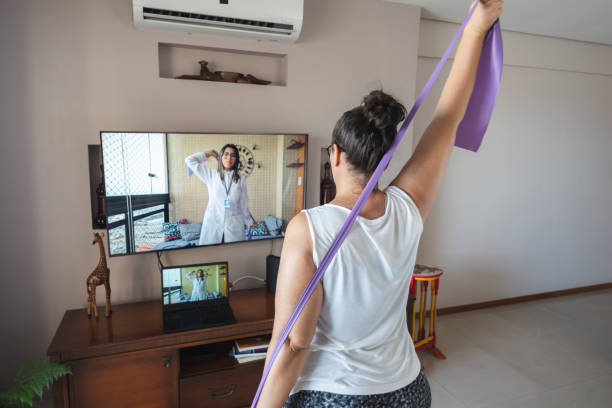This article covers 5 essential telehealth use cases for healthcare delivery. Each of these use cases showcases the potential of telehealth to improve patient access, enhance outcomes, and address disparities in healthcare delivery. Additionally, we will look into the role of modern healthcare technologies, such as video conferencing applications and mobile health apps, in facilitating telehealth services.
Diverse Telehealth Use Cases
Advancements in healthcare technology have expanded telehealth use cases, offering patients enhanced convenience and accessibility to medical services. Patients can attend virtual appointments with healthcare professionals without enduring long waits in crowded waiting rooms, reducing the risk of exposure to germs.
Telehealth extends the geographical reach of healthcare services, enabling providers to reach patients residing in rural areas. This extends their ability to practice and serve patients outside their vicinity. By integrating telehealth, providers can attract more patients seeking non-urgent care. Moreover, telehealth solutions allow healthcare professionals to optimize their schedules with access to virtual waiting rooms and facilitate virtual check-ups during downtime.
1. Telehealth Use Cases: Telemedicine
Telemedicine is the first of 5 telehealth use cases covered in this article. Telemedicine is often used interchangeably with telehealth. However, according to the Health Resources Administration (HRSA), telehealth differs from telemedicine. Telehealth encompasses a broader scope of remote healthcare services than telemedicine. Telemedicine deals specifically with remote clinical services. At the same time, telehealth can refer to remote non-clinical services. For example, provider training, administrative meetings, continuing medical education, and clinical services.
2. Telehealth Use Cases: Pregnancy Care
Telehealth use cases include pregnancy care. The Centers for Disease Control and Prevention reported that the current maternal mortality rate is 17.4 deaths per 100,000 live births. Unfortunately, achieving health equity in maternal care has been an ongoing challenge.
Over 65 percent of pregnancy-related deaths are preventable. Ensuring the well-being of pregnant patients and their newborns hinges on effective maternal healthcare. This is particularly true for residents of rural and underserved areas. HRSA reports that telehealth emerges as a promising solution to bridge these disparities.
Telemedicine uses approaches to prenatal and postpartum care with at-home monitoring for conditions such as diabetes and hypertension. Devices such as remote patient monitoring scales can be used to monitor weight in pregnancy. In addition, phone and video consultations with specialists are commonly used.
3. Telehealth Use Cases: Physical Therapy
Physical therapy is a frequently seen telehealth use case. Virtual physical therapy provides a convenient solution for patients needing neurological, orthopedic, and geriatric physical therapies. Patients receive guidance through exercises, injury prevention, and treatment without the need for frequent office visits, ushering in a new era of healthcare accessibility. However, telehealth appointments are not a substitute for required in-person appointments. Some common tele-PT practice areas include:
- Pediatric and school-based therapy
- Sports injuries
- Lower limb injuries
- Lower back pain
- Functional movement screen
- Post-discharge checkups and safety screens
- Prevention of readmission through home safety evaluations and mobility screens
4. Telehealth Use Cases: Remote Patient Monitoring
Telehealth enables remote patient monitoring, allowing healthcare providers to gather patient data outside the traditional examination room securely. Remote monitoring tools track vital signs such as blood pressure, oxygen, and heart rate. Data is collected through remote patient monitoring devices, wearables, or implantable medical devices. Remote patient monitoring use cases encompass various healthcare scenarios, from chronic disease management and cardiovascular and cancer care to dementia care, postoperative monitoring, and more.
5. Telehealth Use Cases: Dementia Care
The older population has grown significantly, from 4.9 million individuals (4.7% of the total U.S. population) in 1920 to 55.8 million (16.8%) in 2020. This represents a remarkable growth rate of approximately 1,000%, nearly five times the growth rate of the total population (around 200%). Thankfully, telehealth and remote patient monitoring bridge geographical gaps, connecting patients with Alzheimer’s and dementia specialists regardless of location.
A study on telehealth for dementia care during the COVID-19 pandemic found that telehealth is accepted as a viable alternative to in-person care for people with dementia and their caregivers. Positive user experiences were reported, but barriers to individuals, infrastructure, and telehealth environments were identified. Future research should address these barriers and expand the evidence base.
Telehealth and Modern Healthcare Technologies
In this section, we explore the pivotal role of video conferencing applications in modern healthcare, particularly within telehealth use cases. Privacy and reliability are non-negotiable in telehealth, and video conferencing platforms are tasked with meeting these demands while seamlessly integrating with electronic health records. However, it’s important to acknowledge the limitations of telehealth, especially concerning certain medical conditions.
Privacy and reliability are paramount when considering telehealth use cases, and video conferencing applications for healthcare must adhere to HIPAA regulations, ensuring the encryption of transmitted personal data within these telehealth use cases. These applications can integrate with electronic health record systems, allowing secure communication between patients and healthcare providers. It is important to note that telehealth cannot replace in-person visits for certain medical conditions.
Mobile health applications (mHealth) have gained widespread adoption, offering wellness monitoring, remote diagnostics, and patient communication solutions. Even those less tech-savvy are embracing these user-friendly apps, appreciating the convenience they bring to healthcare management.
Understanding Telehealth Use Cases
Whether your healthcare partners are interested in adopting remote patient monitoring to increase patient engagement, create a more efficient workflow, or increase revenue, Tenovi can help you find the best remote patient monitoring solution. You can book a free demo today.


